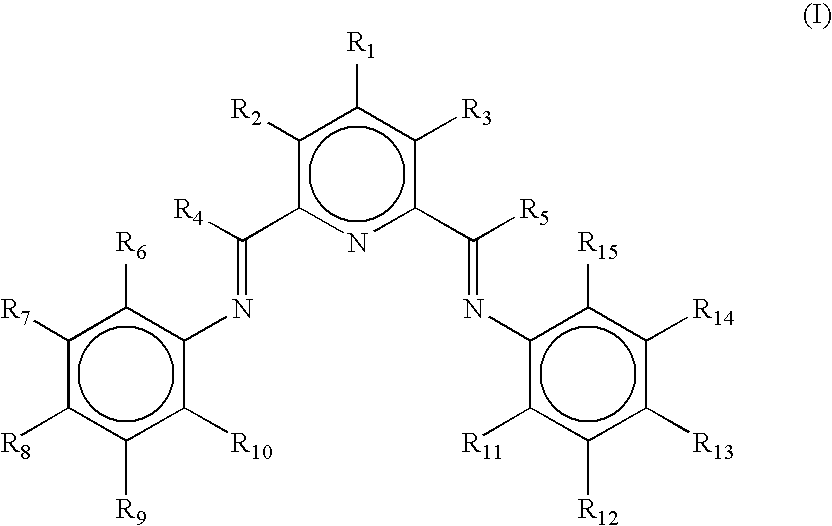Transition metal complexes
a metal complex and metal technology, applied in the field of transition metal complexes, can solve the problems of low solubility in non-polar media, difficult to accurately dose the catalyst system into the reactor, and less favorable processing conditions
- Summary
- Abstract
- Description
- Claims
- Application Information
AI Technical Summary
Benefits of technology
Problems solved by technology
Method used
Image
Examples
examples 3-10
[0244] Alternatively, the catalysts used in the experiments below were 2-[1-(2,4,6-trimethylphenylimino)ethyl]-6-[1-(4-eicosanoxy-3,5-diphenylphenylimino)ethyl] pyridine iron[II] dichloride complex, 2-[1-(2,4,6-trimethylphenylimino)ethyl]-6-[1-(4-eicosanoxy-3,5-diphenylphenylimino)ethyl]pyridine cobalt[II] dichloride complex, 2-[1-(2,4,6-trimethylphenylimino)ethyl]-6-[1-(4-eicosanoxy-3,5-diphenylphenylimino)ethyl] pyridine cobalt[II] chloride tetrakis[3,5-bis[trifluoromethyl)phenyl] borate, 2-[1-(2,4,6-trimethylphenylimino)ethyl]-6-[1-(4-eicosanoxy-3,5-diphenylphenylimino)ethyl] pyridine chromium[III] trichloride complex, 2,6-bis [1-(4-eicosanoxy-3,5-diphenylphenylimino)ethyl]pyridine iron[II] dichloride complex, 2,6-bis[1-(4-eicosanoxy-3,5-diphenylphenylimino)ethyl]pyridine cobalt[II] dichloride complex, 2,6-bis[1-(4-eicosanoxy-3,5-diphenylphenylimino) ethyl]pyridine chromium[III] trichloride complex and 2-[1-(2-tert-butylphenylimino)ethyl]-6-[1-(4-eicosanoxy-3,5-diphenylphenylimin...
example 3
Preparation of 2-[1-(2,4,6-trimethylphenylimino)ethyl]-6-[1-(4-eicosanoxy-3,5-diphenylphenylimino)ethyl] pyridine iron[II] dichloride complex, (E)
[0257]
[0258] In an inert atmosphere a solution of 5 g above-described diimine (D) in 20 ml dichloromethane was added to 788 mg FeCl2 in 30 ml dichloromethane. The mixture was stirred for 16 hours. The solution was filtrated, and the solvent was removed in vacuo. The resulting green blue product was washed with pentane, isolated by filtration and dried in vacuo.
[0259] Yield 5 g (86%) of iron complex E.
[0260]1H-NMR (CD2Cl2, broad signals, selected data) δ 81.4 (1H, Py-Hm), 80.5 (1H, Py-Hm), 21.1 (3H, Me), 17.3 (6H, Me), 16.0 (2H, ArH), 0.21 (3H, Me), −13.8 (2H, ArH), −30.4 (3H, Me).
[0261] Its solubility in toluene or benzene-D6 is estimated at ca. 50 mg / ml at 20° C.
example 4
[0262] Preparation of 2-[1-(2,4,6-trimethylphenylimino)ethyl]-6-[1-(4-eicosanoxy-3,5-diphenylphenylimino)ethyl]pyridine cobalt[II] dichloride complex, (F)
[0263] In an inert atmosphere a solution of 1.44 g (1.79 mmol) diimine D, (Mes / Sol20), in 10 ml dichloromethane was added to 220 mg CoCl2 (1.69 mmol) in 10 ml dichloromethane. The mixture was stirred for 16 hours. After filtration the solution was concentrated by removing part of the solvent in vacuo. The product was precipitated from the resulting solution (˜5 ml) by addition of 15 ml pentane. The yellow brown solid was isolated by centrifugation, washed with pentane and dried in vacuo. Yield 1.25 g (79%) of cobalt complex F.
[0264]1H-NMR (CD2Cl2, broad signals, selected data) δ 106.5 (1H, Py-Hm), 105.6 (1H, Py-Hm), 12.8 (1H, Py-Hp), 11.8 (3H, Me), 3.4 (2H), 2.9 (4H), 0.1 (2H), −0.2 (2H), −0.7 (2H), −1.5 (2H), −1.8 (2H), −2.4 (2H), −10.5 (3H, Me), −16.6 (6H, Me), −60.9 (2H, ArH).
PUM
| Property | Measurement | Unit |
|---|---|---|
| Temperature | aaaaa | aaaaa |
| Volume | aaaaa | aaaaa |
| Fraction | aaaaa | aaaaa |
Abstract
Description
Claims
Application Information
 Login to View More
Login to View More - R&D
- Intellectual Property
- Life Sciences
- Materials
- Tech Scout
- Unparalleled Data Quality
- Higher Quality Content
- 60% Fewer Hallucinations
Browse by: Latest US Patents, China's latest patents, Technical Efficacy Thesaurus, Application Domain, Technology Topic, Popular Technical Reports.
© 2025 PatSnap. All rights reserved.Legal|Privacy policy|Modern Slavery Act Transparency Statement|Sitemap|About US| Contact US: help@patsnap.com



